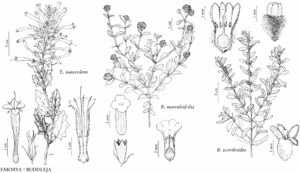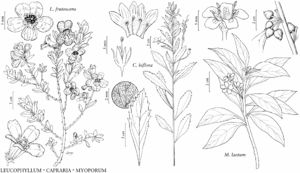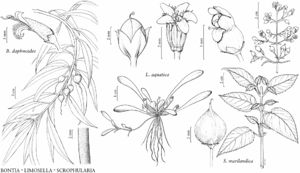Difference between revisions of "Scrophulariaceae"
FNA>Volume Importer |
imported>Volume Importer |
||
| Line 147: | Line 147: | ||
|publication year= | |publication year= | ||
|special status= | |special status= | ||
| − | |source xml=https:// | + | |source xml=https://bibilujan@bitbucket.org/aafc-mbb/fna-data-curation.git/src/bb6b7e3a7de7d3b7888a1ad48c7fd8f5c722d8d6/coarse_grained_fna_xml/V17/V17_4.xml |
}}<!-- | }}<!-- | ||
-->[[Category:Treatment]] | -->[[Category:Treatment]] | ||
Revision as of 20:24, 27 May 2020
Shrubs, subshrubs, trees, or herbs, annual, biennial, or perennial, not fleshy [fleshy], autotrophic. Stems prostrate, ascending, pendent, or erect. Leaves deciduous, semipersistent, or persistent, basal and cauline or cauline, opposite or alternate, simple; stipules absent or present (most Buddleja, Emorya, Limosella); petiole present or absent; blade fleshy or not, leathery or not, margins entire to subentire, undulate, toothed, lobed, divided, or incised. Inflorescences terminal, subterminal, or axillary, racemes, cymes, panicles, or thyrses (or combinations thereof), spikes, fascicles, or flowers 1(or 2). Flowers bisexual or unisexual (some Buddleja), perianth and androecium hypogynous; sepals 4 or 5, ± distinct (Capraria), connate proximally, or to past middle (Limosella), calyx radially or bilaterally symmetric; petals 4 or 5, proximally connate, corolla radially or bilaterally symmetric, regular or bilabiate, rotate to salverform, tubular, funnelform, or campanulate; stamens mostly 4 or 5(–8 in Myoporum), adnate to corolla, didynamous or equal, staminode 0 or 1; pistil 1, 2-carpellate, ovary superior, 2- or 4-locular (partition incomplete and ovary 1-locular distally in Limosella), placentation axile (free-central in Limosella, apical in Myoporum); ovules anatropous or hemitropous (Buddleja), unitegmic, tenuinucellate; style 1; stigma 1, sometimes 2-lobed. Fruits capsules, dry and dehiscence septicidal or loculicidal, or fleshy and drupelike (Bontia, Myoporum) or berries (some Buddleja), [schizocarps]. Seeds 1–300, white, yellow, orangish, brown, or black, ovoid, oblong-ovoid, conic, ellipsoid, L-shaped, angled, cylindric, threadlike, or fusiform; embryo straight or slightly curved, endosperm abundant or not.
Distribution
nearly worldwide except boreal and arctic North America and Asia, tropical Africa, Antarctica.
Discussion
Genera ca. 60, species ca. 1700 (9 genera, 45 species in the flora).
As noted in the introduction to this volume, the authors follow a narrow circumscription of Scrophulariaceae. Molecular studies (especially R. G. Olmstead et al. 2001 and B. Oxelman et al. 2005) have shown that some of the taxa commonly included in earlier treatments of Scrophulariaceae are better placed elsewhere, particularly in Orobanchaceae (hemiparasitic members, for example, Rhinantheae Lamarck & de Candolle) and Plantaginaceae (for example, Penstemon). Oxelman et al. and D. C. Tank et al. (2006) both recognized eight tribes in their analyses of the Scrophulariaceae. Five of the eight, Buddlejeae Bartling (Buddleja, Emorya), Leucophylleae Miers (Capraria, Leucophyllum), Limoselleae Dumortier (Limosella), Myoporeae Reichenbach (Bontia, Myoporum), and Scrophularieae Dumortier (Scrophularia, Verbascum), are represented in the flora area.
Inclusion of Myoporaceae (three or four genera and 125 species, in the sense of A. Cronquist 1981) is warranted based on its close similarity to Leucophylleae. Morphological similarities have led workers either to propose transferring Leucophylleae from Scrophulariaceae to Myoporaceae (C. J. Niezgoda and A. S. Tomb 1975) or to question the validity of recognizing Myoporaceae as distinct from Scrophulariaceae (J. Henrickson and L. D. Flyr 1985). R. G. Olmstead et al. (2001) confirmed this closeness in their molecular survey, with Leucophyllum and Myoporum clustering together and forming a clade sister to Buddlejaceae; Leucophylleae and Myoporeae also clustered together in the studies by B. Oxelman et al. (2005) and E. Gándara and V. Sosa (2013).
Members of Buddlejaceae (10 genera, ca. 150 species, in the sense of A. Cronquist 1981) often have been included in Loganiaceae (G. K. Rogers 1986) or treated as a separate family. Cronquist noted that the four-lobed corolla may be the primitive condition for the Scrophulariales and that Buddlejaceae is clearly not primitive. B. Oxelman et al. (1999) showed that Buddlejaceae is monophyletic; R. G. Olmstead et al. (2001) and Oxelman et al. (2005) both found that Buddleja clustered within Scrophulariaceae in the strict sense; that interpretation is followed here. J. H. Chau et al. (2017) found that Buddlejeae is monophyletic.
Selected References
Lower Taxa
Illustrations
Key
| 1 | Herbs or subshrubs. | > 2 |
| 2 | Plants aquatic or paludal; stems prostrate or ascending; leaves basal; stolons present. | Limosella |
| 2 | Plants terrestrial; stems erect; leaves basal and cauline or cauline; stolons absent. | > 3 |
| 3 | Leaves opposite. | Scrophularia |
| 3 | Leaves alternate. | > 4 |
| 4 | Leaf surfaces with punctate glands and internal secretory oil cavities; inflorescences axillary, racemes. | Capraria |
| 4 | Leaf surfaces without punctate glands and internal secretory oil cavities; inflorescences terminal, spikes, racemes, or panicles. | Verbascum |
| 1 | Shrubs or trees. | > 5 |
| 5 | Sepals 4; stipules usually present or as stipular lines. | > 6 |
| 6 | Calyx lobes linear-subulate; corollas long-tubular. | Emorya |
| 6 | Calyx lobes ovate to lanceolate; corollas campanulate-rotate, salverform, funnelform, or tubular. | Buddleja |
| 5 | Sepals 5; stipules absent. | > 7 |
| 7 | Stems densely silvery gray-tomentose, sometimes appressed-stellate; corollas purplish lavender to violet or blue, rarely white, with white in proximal throat, usually marked with yellow-brown, orange, or purple-violet spots; fruits capsules, dry. | Leucophyllum |
| 7 | Stems glabrous; corollas white, spotted with purple, or buff or coppery brown to greenish tan; fruits drupelike capsules, fleshy. | > 8 |
| 8 | Corollas white, spotted with purple. | Myoporum |
| 8 | Corollas buff or coppery brown to greenish tan. | Bontia |


